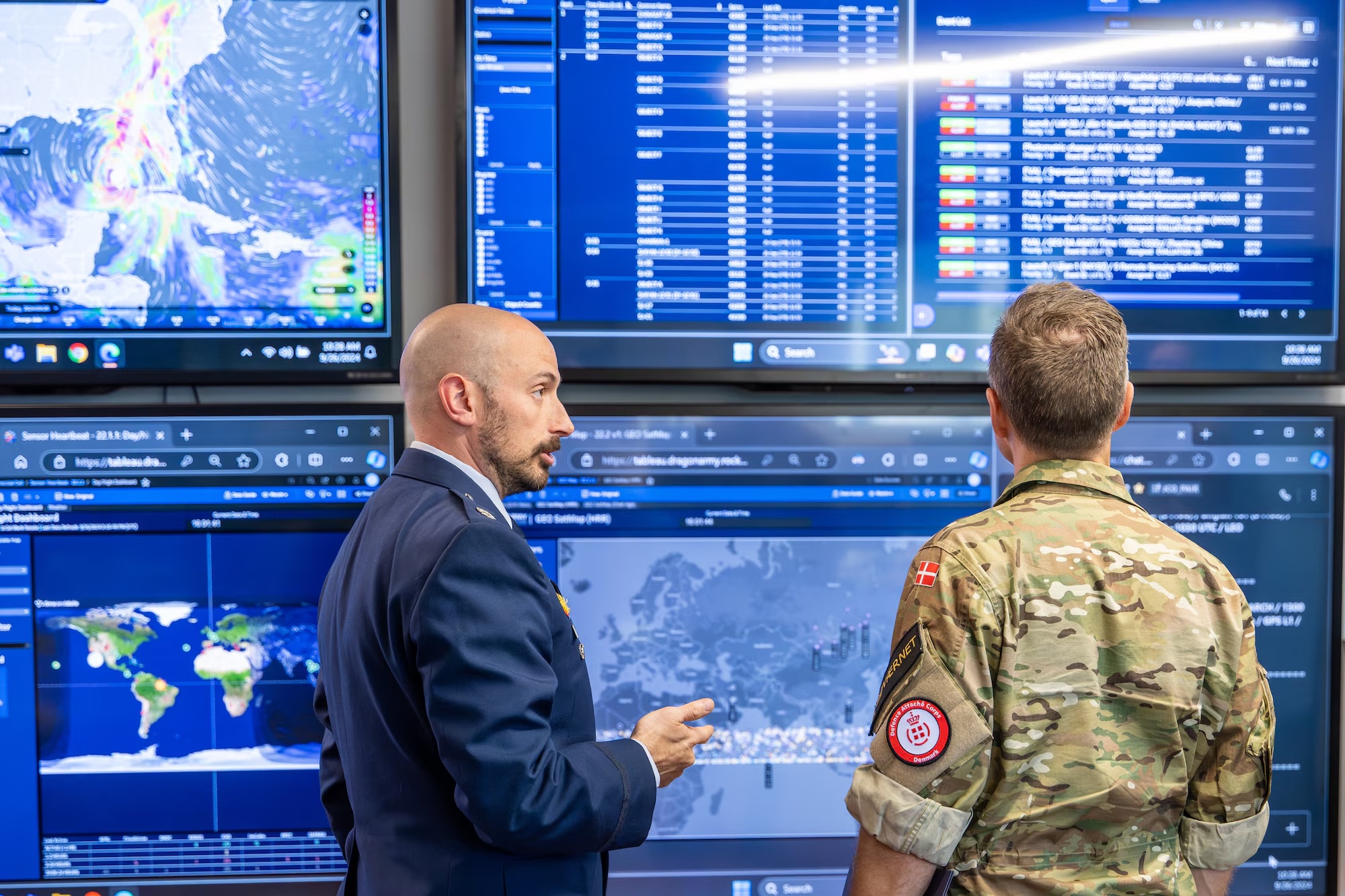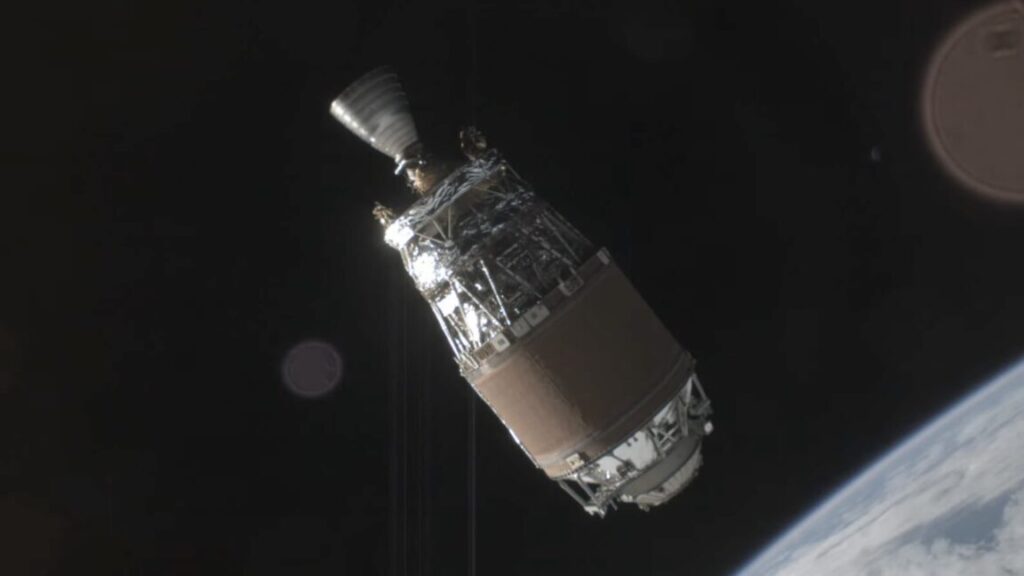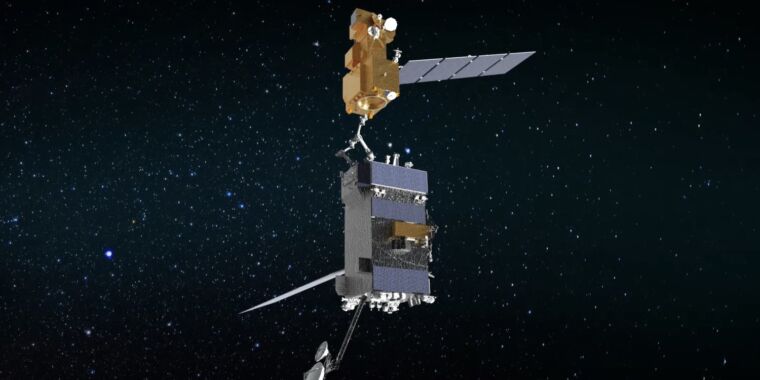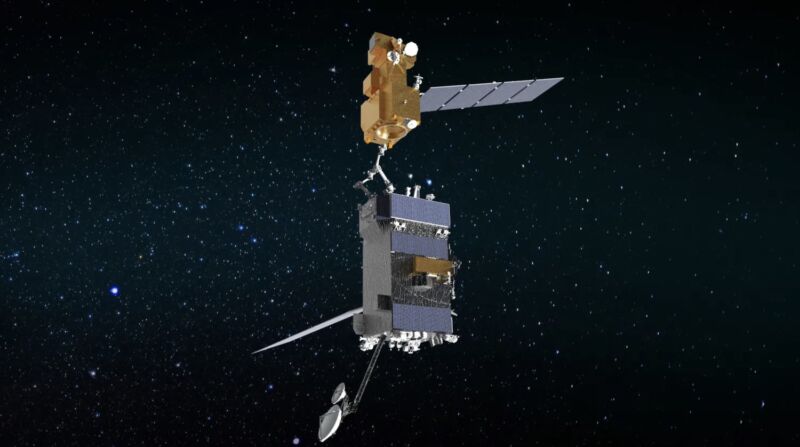China jumps ahead in the race to achieve a new kind of reuse in space
The SJ-21 and SJ-25 satellites “merged” on July 2 and have remained together since then.
This image from a telescope operated by s2a systems, a Swiss space domain awareness company, shows China’s SJ-21 and SJ-25 satellites flying near one another on June 26. Credit: s2a systems
Two Chinese satellites have rendezvoused with one another more than 20,000 miles above the Earth in what analysts believe is the first high-altitude attempt at orbital refueling.
China’s Shijian-21 and Shijian-25 satellites, known as SJ-21 and SJ-25 for short, likely docked together in geosynchronous orbit sometime last week. This is the conclusion of multiple civilian satellite trackers using open source imagery showing the two satellites coming together, then becoming indistinguishable as a single object.
Chinese officials have released no recent public information on what the two satellites are up to, but they’ve said a bit about their missions in prior statements.
SJ-25, which launched in January, is designed “for the verification of satellite fuel replenishment and life extension service technologies,” according to the Shanghai Academy of Spaceflight Technology, the Chinese state-owned contractor that developed the satellite. SJ-21 launched in 2021 and docked with a defunct Chinese Beidou navigation satellite in geosynchronous orbit, then towed it to a higher altitude for disposal before returning to the geosynchronous belt. Chinese officials described this demonstration as a test of “space debris mitigation” techniques.
More than meets the eye
These kinds of technologies are dual-use, meaning they have civilian and military applications. For example, a docking in geosynchronous orbit could foretell an emerging capability for China to approach, capture, and disable another country’s satellite. At the same time, the US Space Force is interested in orbital refueling as it seeks out ways to extend the lives of military satellites, which are often limited by finite fuel supplies.
The Space Force sometimes calls this concept dynamic space operations. While some military leaders remain skeptical about the payoff of in-space refueling, the Space Force has an agreement with Astroscale to perform the first refueling of a US military asset in orbit as soon as next year.
China appears to be poised to beat the US Space Force to the punch. The apparent docking of the two satellites last week suggests SJ-21 is the target for SJ-25’s refueling demonstration, and US officials are watching. Two of the Space Force’s inspector satellites, known by the acronym GSSAP, positioned themselves near SJ-21 and SJ-25 to get a closer look.
Retired Space Force Lt. Gen. John Shaw is a vocal proponent of dynamic space operations. Because of this, he’s interested in what happens with SJ-21 and SJ-25. Shaw was deputy commander of US Space Command before his retirement in 2023. In this role, Shaw had some oversight over GSSAP satellites as they roamed geosynchronous orbit.
“The theory behind dynamic space operations stemmed from a kind of operational frustration with our inability to conduct the full range of activities with GSSAP that we wanted to at Space Command, as the warfighter—largely due to the combination of fixed fuel availability and expected satellite lifetime,” Shaw told Ars.
As other countries, mainly China, step up their clandestine activities in orbit, military officials are asking more of the GSSAP satellites.
“It was operationally driven then, a couple years ago, but it’s now manifesting itself in much wider ways than even it did back then, particularly in the face of activities by potential adversaries,” Shaw said. “That’s why I’m more confident and even more zealous about it.”
Geosynchronous orbit is a popular location for military and commercial satellites. At an altitude of some 22,236 miles (35,786 kilometers), a satellite’s orbital velocity perfectly matches the speed of Earth’s rotation, meaning a spacecraft has a fixed view of the same region of the planet 24 hours per day. This is useful for satellites providing military forces with secure strategic communications and early warning of missile attacks.
Now, geosynchronous orbit is becoming a proving ground for new kinds of spacecraft to inspect or potentially attack other satellites. Ground-based anti-satellite missiles aren’t as useful in striking targets in high-altitude orbits, and there’s a consensus that, if you were to attack an enemy satellite, it would make more sense to use a weapons platform already in space that could move in and connect with the target without blowing it up and creating a cloud of dangerous space junk.
Keeping watch
The US military’s GSSAP satellites began launching in 2014. They carry enough propellant to maneuver around geosynchronous orbit and approach objects for closer inspection, but there’s a limit to what they can do. Six GSSAP satellites have been launched to date, but the Space Force decommissioned one of them in 2023. Meanwhile, China’s satellite operators are watching the watchers.
“We’ve seen where GSSAP safely and responsibly approaches a Chinese vehicle, and it just quickly maneuvers away,” Shaw said. “We tend to fly our GSSAPs like dirigibles, using relatively slow, minimum energy transfer approaches. The Chinese know that we do that, so it is relatively easy for them to maneuver away today to avoid such an approach.
“If tomorrow they’re able to refuel at will and operate even more dynamically, then the marginal cost of those maneuvers for them becomes even lower, and the challenge for GSSAP becomes even greater,” Shaw said.

Danish Rear Admiral Damgaard Rousøe, Danish Defence Attaché, right, observes space domain awareness data with US Space Force Lt. Col. Mark Natale, left, Joint Commercial Operations cell director, in Colorado Springs, Colorado, on September 26, 2024. Credit: US Space Force/Dalton Prejeant
China launched a satellite into geosynchronous orbit in 2016 with a robotic arm that could grab onto another object in space, then sent SJ-21 into orbit four years ago on its “space debris mitigation” mission.
Northrop Grumman launched two satellites in 2019 and 2020 that accomplished the first dockings in geosynchronous orbit. Northrop’s satellites, which it calls Mission Extension Vehicles, took control of two aging commercial communications satellites running low on fuel, maneuvering them to new locations and allowing them to continue operating for several more years. It’s easy to see that this kind of technology could be used for commercial or military purposes.
But these Mission Extension Vehicles don’t have the ability to transfer fluids from one satellite to another. That is the step China is taking with SJ-21 and SJ-25, presumably with hydrazine and nitrogen tetroxide propellants, which most satellites use because they combust on contact with one another.
US Space Command’s Joint Commercial Operations cell, which collects unclassified satellite monitoring data to bolster the military’s classified data sources, estimated the SJ-21 and SJ-25 satellites “merged” on July 2 and have remained together since then. The video below, released by s2a systems, shows SJ-25 approaching SJ-21 on June 30.
A time-lapse of yesterday’s SJ-25 / SJ-21 coverage, recorded from 08: 30 to 20: 53 UTC. pic.twitter.com/HUPWBTXZc9
— s2a systems (@s2a_systems) July 1, 2025
The unclassified data does not confirm that the two satellites actually docked, but that is likely what happened. The satellites came together, or merged, on June 13 and June 30 but separated again within a few hours. These may have been practice runs, aborted docking attempts, or sudden maneuvers to avoid the prying eyes of the US military’s GSSAP satellites loitering nearby.
Now, the SJ-21 and SJ-25 have been flying together for more than five days with no discernible changes detected from ground-based telescopes. Thousands of miles over the equator, the two satellites appear only as dots in the viewfinders of these telescopes positioned around the globe.
What we don’t know
COMSPOC is a Pennsylvania-based company that collects and processes data from commercial satellite tracking sensors. COMSPOC fuses optical telescope imagery with radar tracking and passive radio frequency (RF) data, which uses radio signals to measure exact distances to satellites in space, to get the best possible estimate of a spacecraft’s position.
“With most telescopes… at 1 kilometer or a half a kilometer, somewhere in there, you’re going to start to lose it when they get that close,” said Paul Graziani, COMSPOC’s founder and CEO, in an interview with Ars. “I think it’d be difficult for any telescope, even a really capable one, to get within 100 meters. That seems to be a stretch for telescopes.”
That’s why it’s helpful to add radar and RF data to the mix.
“When you add all of that together, you become much better than the 1-kilometer [precision] that a ‘scope might be,” said Joe Callaro, COMSPOC’s director of operations. “RF tells you if part of that blob is moving and the other part isn’t, and even when they all become one pixel, you can tell things about that.”
Even then, companies like COMSPOC have a degree of uncertainty in their conclusions unless Chinese or US officials make a more definitive statement.
“We are not working with the government,” Callaro told Ars before last week’s apparent docking. “We are not clearing this. The charge that I have for my team is we won’t make assertions as to what’s going on. We will only tell what our software gives us as a solution. We can say, ‘Here are the elements, here’s the visual, but what it means and what it’s doing, we will not assert.’
“We will not say they’re docked because unless they told me, I wouldn’t know that,” Callaro said. “So, we will say they’ve been together for this amount of time, that the mission could have happened, and then they separated, became two, and separated at whatever speed.”
SJ-21’s behavior for the last couple of years suggested it was running empty after undertaking large propulsive maneuvers to capture the Chinese Beidou satellite and move it to a different orbit.
Callaro served as a tactician in the Air Force’s Joint Space Operations Center, then joined the Aerospace Corporation before taking the job as operations lead at COMSPOC. He doesn’t buy China’s suggestion that SJ-21 was purely an experiment in collecting space debris.
“That is not how I see that at all,” Callaro said. “The fact that we can calculate all the maneuvers it takes to get out and get back, and the fact that afterwards, it spent a couple of years basically not moving, probably because it was low on fuel, sets up the idea [that there’s more to SJ-21’s mission]. Now, SJ-25 goes out there, and it’s supposed to be a fuel tank, and it’s perfectly aligned with SJ-21 and now we see this happening, tells me that it’s much more a counter-space capability than it is a trash remove. But that’s what they say.”
Unless China makes a public statement on the refueling of SJ-21 by SJ-25, observers won’t know for sure if the servicing demo was successful until the satellites detach. Then, US officials and independent analysts will watch to see if SJ-21 makes any substantial maneuvers, which might indicate the satellite has a full tank of gas for whatever mission Chinese officials send it off to do next.
Listing image: Costfoto/Future Publishing via Getty Images
China jumps ahead in the race to achieve a new kind of reuse in space Read More »




